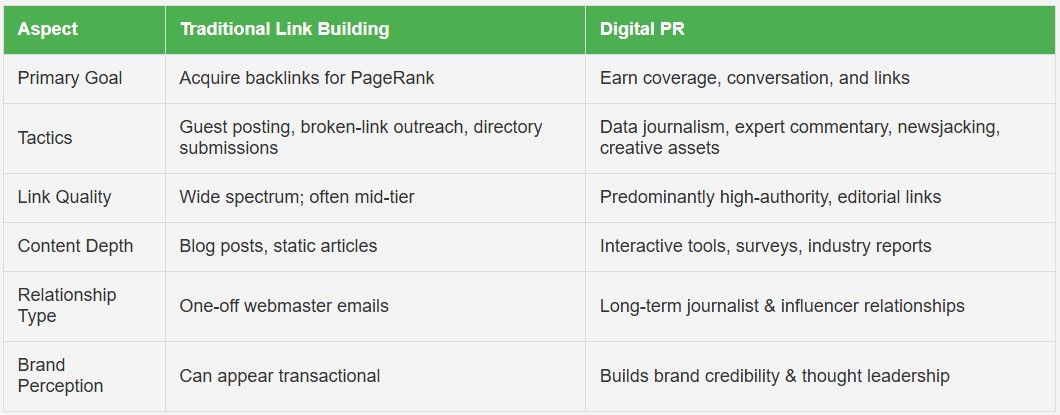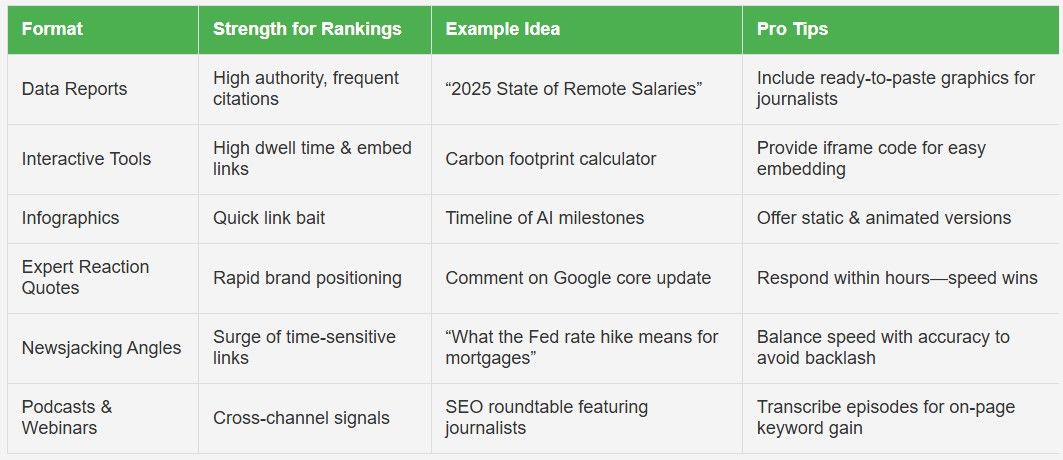The New Currency of Authority
Search engines once rewarded sheer keyword density; today they prize authority, relevance, and buzz. Digital PR—Public Relations executed primarily through online channels—has emerged as an indispensable lever for acquiring that currency. By blending classic PR storytelling with SEO-centered tactics such as link earning, data-led campaigns, and influencer outreach, Digital PR propels brands to the forefront of search results and public consciousness simultaneously. Yet many marketers still treat it as a buzzword rather than a structured discipline. In this guide you will learn exactly what Digital PR is, how it differs from traditional link building, and—most importantly—why it can move your rankings faster than almost any other off-page strategy.
Defining Digital PR (Beyond Link Building)
At its core, Digital PR is the art of earning media coverage and backlinks through online storytelling, data, and relationships. Whereas classic PR chases column inches on paper, Digital PR seeks authoritative website mentions on outlets like Forbes or TechCrunch, high-quality backlinks that feed search algorithms credibility signals, social amplification through influencer citations, and brand-sentiment shaping via expert commentary and crisis response. The discipline therefore pulls from journalism, content marketing, data analysis, and SEO. A campaign might commission proprietary research, craft an interactive visual, pitch journalists, and seed the asset across social channels—all with the dual goal of newsworthiness for humans and ranking signals for algorithms. It is simultaneously artistic storytelling and technical SEO science.
The Ranking Equation: How Digital PR Influences SEO
- Authority boost: Top-tier media links carry high Domain Authority. A single mention from The Guardian can outweigh dozens of directory links because editorial coverage passes full “follow” equity.
- Relevance alignment: Campaigns are tailored to verticals, generating contextually related anchor text and thematic authority. Thought-leadership quotes place brand experts next to target keywords, reinforcing topical relevance.
- Behavioral signals: Earned media drives referral traffic that often exhibits high click-through, low bounce, and strong on-site engagement—user metrics that hint to Google that content satisfies intent. Social buzz, while not a direct PageRank factor, correlates with link velocity and awareness.
Think of Digital PR as a multivitamin for SEO: while technical audits fix crawling issues and on-page tweaks perfect headline tags, Digital PR injects the nutrients Google craves—trust, authority, and fresh mentions.
Digital PR vs. Traditional Link Building

Core Components of a High-Impact Digital PR Campaign
Effective campaigns begin with insight mining, where search gaps, social chatter, and newsroom calendars are examined to discover hooks that will resonate. Practitioners then generate data or craft a story—often by running statistically significant surveys, scraping public databases, or repurposing underused internal metrics—to create something original and credible. Visual and interactive asset production follows, because journalists are far more likely to embed a calculator or colorful graphic than a plain paragraph.
A carefully segmented media list is built so that each pitch lands with a writer whose beat, tone, and posting cadence align perfectly, and personalized pitching turns that research into subject lines and concise bodies that spotlight exclusive angles rather than product plugs. Once coverage begins, amplification across LinkedIn, X, and niche Slack communities creates a feedback loop that alerts secondary publications. Finally, measurement closes the loop by tracking coverage, referral sessions, Domain Rating, and keyword movement so attribution reveals which parts of the campaign generated the greatest ROI.
Why Digital PR Links Carry Extra SEO Weight
Links earned through Digital PR tend to outperform conventional backlinks on several fronts. First, outlets with high Trust Flow and Domain Authority effectively lend their reputational capital to every site they cite, cascading power downstream. Second, because journalists—not marketers—choose the anchor text, the resulting anchor portfolio is naturally diverse and therefore safer from over-optimization penalties. Freshness matters as well; an ongoing cadence of press mentions keeps a domain in a perpetual “buzz” state that algorithms interpret as contemporary relevance. Contextual placement deepens the benefit: editorial paragraphs surrounding a link supply semantically rich language that reinforces entity relationships in Google’s Knowledge Graph. Finally, difficulty builds defensibility—securing BBC or CNBC coverage is hard, and that barrier to entry becomes a competitive moat once you achieve it.
Real-World Ranking Wins: Micro Case Studies
FinTech Startup “CoinCrest” set out to rank for “best crypto savings account.” By publishing a comparative APY study across 25 exchanges and pitching the results, it secured 110 referring domains—including CNBC—and jumped from position 34 to 2 within four months while tripling organic traffic.
Sustainable Fashion Brand “Re-Wear It” created an interactive map visualizing water consumption by denim factories worldwide. The Guardian’s Green Light column embedded the asset, dozens of eco-sites followed, and the company’s Domain Rating rose twelve points alongside a 22 % sales lift.
B2B SaaS “WorkflowHub” supplied expert commentary during the global shift to remote work. Quotes in Forbes, ZDNet, and Wired generated fifty do-follow links; the site climbed from page five to page one for “project management software,” with authority spilling over to 300 mid-tail keywords.
Common Digital PR Formats & Their Ranking Impact

Building a Repeatable Digital PR Process
Success rests on discipline. Teams begin with quarterly ideation sprints that weigh evergreen against seasonal angles and score them on news value, keyword synergy, and data availability. The selected ideas slot into an editorial calendar synchronized with product launches, holidays, or anticipated algorithm updates. Relationship cultivation happens year-round: commenting on journalist threads, sharing their stories, and offering expert quotes so that outreach never feels cold.
Templates and workflows automate repetitive tasks, while bespoke personalization tokens preserve the human touch. A live dashboard merges backlink data from Ahrefs or Semrush with GA4 acquisition reports, allowing marketers to visualize ranking lifts against PR drops. After each campaign, a post-mortem dissects wins and misses, refining playbooks for higher hit rates next quarter.
Avoiding Pitfalls & Google Penalties
- Over-optimized press releases stuffed with keyword anchors invite manual actions; let anchors flow naturally.
- Paid syndication disguised as earned media produces duplicate links that Google ignores.
- Thin data—surveys of 50 respondents—rarely convinces journalists; aim for statistically significant samples.
- Neglecting E-E-A-T undermines credibility; attribute content to real experts and cite sources.
- Earning links to a poorly optimized page squanders equity; ensure target URLs have clear H1s, schema, and engaging UX.
Measuring ROI: From Links to Revenue
Quantifying return on Digital PR involves multiple layers. Link metrics—such as referring domains, Domain Rating growth, and topical relevance—offer a first-line indicator of authority. Ranking movements for keyword clusters connected to each campaign supply a directional gauge of visibility gains. Traffic analytics fill in behavioral detail: new users, pages per session, and newsletter sign-ups reveal whether earned visibility converts to on-site engagement. Further downstream, assisted-conversion modeling in GA4 clarifies how PR-driven sessions influence revenue—or subscription sign-ups—across the buying journey. Finally, shifts in branded-search volume and sentiment tracked through social listening round out the picture, connecting perception to performance.
Future Trends: Where Digital PR & Rankings Intersect
Artificial intelligence is accelerating data journalism, enabling practitioners to mine complex datasets in hours rather than weeks, yet human oversight remains vital for credibility and nuance. Interactive-first assets are gaining prominence as search engines increasingly surface calculators, maps, and other tools directly in results, positioning Digital PR creatives to capture featured snippets while attracting fresh embeds. Google’s shift toward entity-based SEO means that mentions rich in contextual cues fortify Knowledge Graph associations and consolidate topical authority. Multimodal content—from podcasts to Web Stories—will spawn new embed-friendly formats, and as third-party cookies fade, first-party attention cultivated through PR-driven newsletters will weigh more heavily in trust modeling. Those who integrate these trends early will wield a compound advantage.
Step-By-Step 30-Day Kick-Start Plan
During week one, conduct a backlink audit, analyze competitor wins, and brainstorm at least five story angles supported by credible data. Week two pivots to asset creation: commission a survey or scrape public records, shape the findings into digestible insights, design visuals that pop on both desktop and mobile, and publish a keyword-focused landing page engineered for conversions.
In week three, prepare outreach by crafting a segmented media list, personalizing pitches with exclusive hooks, scheduling social snippets for peak engagement windows, and pre-drafting expert quotes for reactive opportunities. Launch in week four: send pitches at optimal times, post teasers across LinkedIn communities and marketing Slack groups, and respond rapidly to journalist feedback with additional context or localized data. Immediately after launch, monitor new backlinks, update the landing page with “As Seen In” logos to boost trust, feed results into your dashboard, and document lessons for the next cycle.
Digital PR as the SEO Force Multiplier
SEO no longer thrives in isolation. Digital PR unites editorial storytelling with search science, delivering authority that algorithms recognize and audiences respect. By earning high-authority links, shaping brand narratives, and sparking social proof, Digital PR not only lifts keyword positions but also builds intangible equity—credibility, trust, and buzz—that compounds over time. In a landscape where everyone is tweaking meta tags, those who master Digital PR gain a moat competitors struggle to cross. Ready to raise your SERP profile and own the conversation? Harness Digital PR and watch your rankings—and reputation—climb in tandem.
